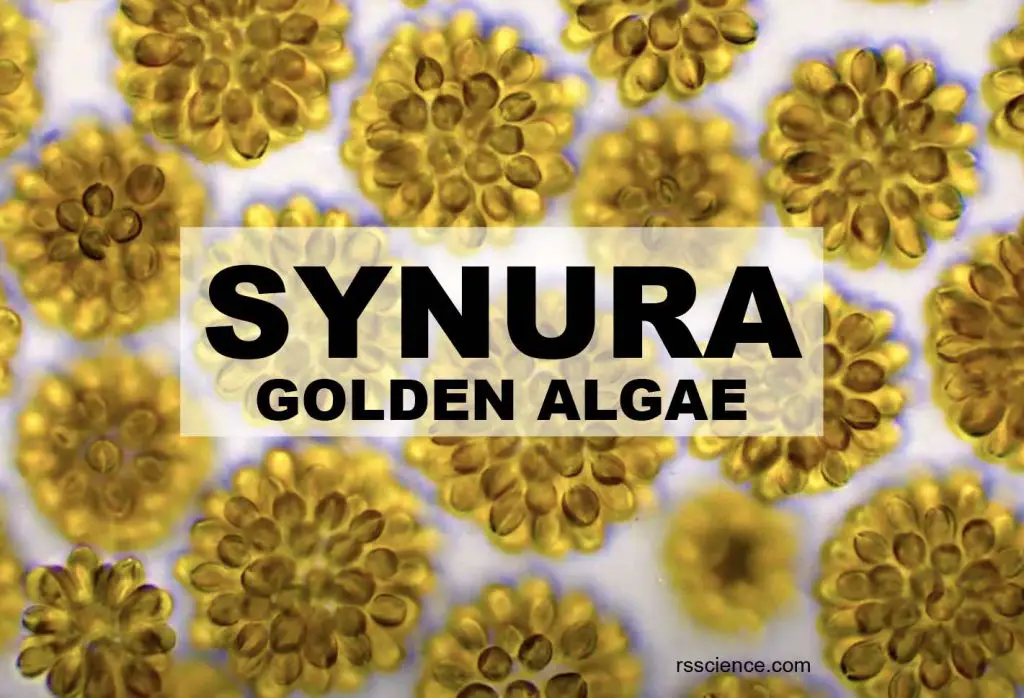This article covers
What is a Synura? A quick overview
Synura is a small group of golden-brown algae containing chloroplasts, found mostly in freshwater. They are covered in silicate scales and of yellowish color. A group of Synura cells tends to aggregate and assemble into a cluster. Each cell has its two flagella facing outward. When they wave their flagella together, the entire cluster starts to rotate. It is super cute and fun to see them rolling this way! I called them microscopic “Roasted Corn on the Cob.”
[In this video] Rolling Synura like a corn cob.
Click the post below to learn more about different microscopic organisms in a drop of pond water.
Classification of Synura
Scientific classification
Domain: Eukaryota
Clade: SAR supergroup
Phylum: Ochrophyta
Class: Synurophyceae
Order: Synurales
Genera: Synurophyte
The classification of Synura (as well as many algae species) is still evolving due to the different classification systems used by the scientific community. Synura was classified as heterokont golden algae. More recently, Synura is a genus name under the Order of Synurales.
There are two major genera in Synurales. Both groups are common plankton in lakes and ponds. You can easily distinguish them based on the behaviors of cells.
Synura
Synura species like to stay together and form spherical colonies. Each colony is around 30-100 μm in diameter.

[In this image] Four genera of Synura in North America.
Image source: modified from Keweenaw.Algae
Mallomonas
Mallomonas species are free-living individual cells, usually 50-100 μm in length. They generally have long spines.
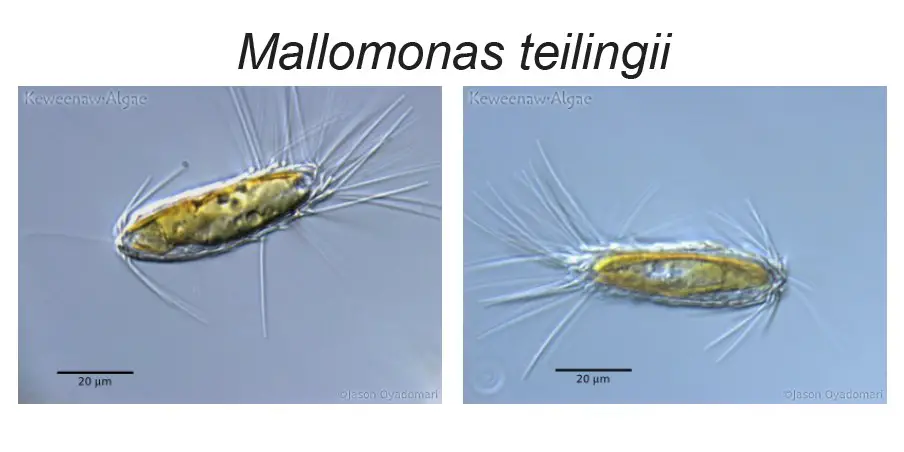
[In this image] An example of Mallomonas species.
Image source: modified from Keweenaw.Algae
The cell structure of Synura
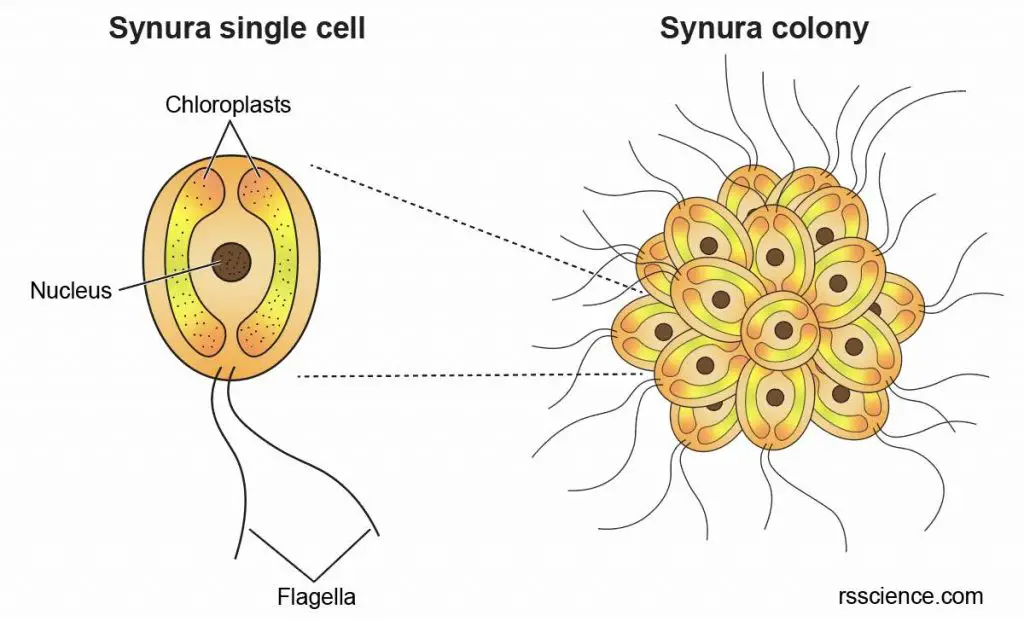
[In this image] The anatomy of Synura single cell and colony.
Chloroplasts
The Synura cells have two parietal, golden-brown chloroplasts. This unique color comes from the pigments, chlorophyll-c1, and fucoxanthin, inside the chloroplasts. Although the pigment molecules are very different from the chloroplasts in green plants, Synura cells still can live by the energy produced from the photosynthesis of their chloroplasts.
Nucleus, flagella, and vacuole
The Synura cells have one nucleus and two flagella. The waving movement of flagella (singular: flagellum) can propel the cells. When several Synura cells assemble into a colony, their flagella stay outward to create a rolling and swimming motion. The end with the flagella is defined as Synura cell’s anterior end; the other side is its posterior end.
A large storage vacuole is sometimes visible in the cell posterior. However, Synuras do not possess eyespots.
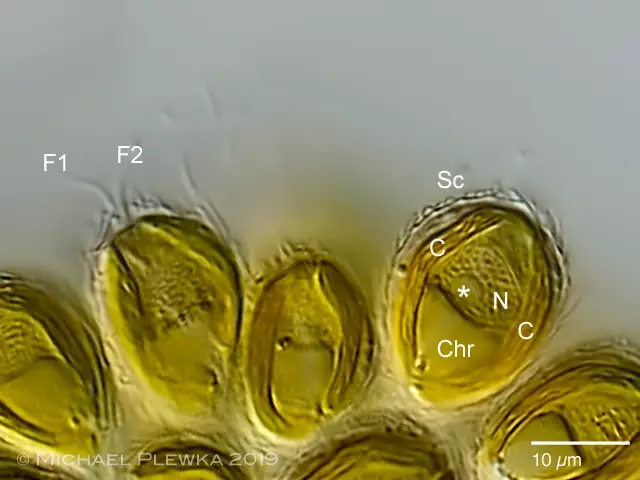
[In this image] A close view of Synura petersenii.
C: chloroplasts, Chr: vacuole, F1/F2: flagella, N: nucleus, *: nucleolus, and Sc: scales.
Image source: plingfactory
Scales
The Synura cells are covered by many protective scales made of silica. These siliceous scales form ordered, overlapping rows arranged in a spiral pattern on the cell surface. Synura scales have unique structures like pores, ribs, and spines. Scientists can use these structural features (looking at them under a scanning electron microscope) to classify different Synura species. Large cells of Synura petersenii may have about 90 scales.
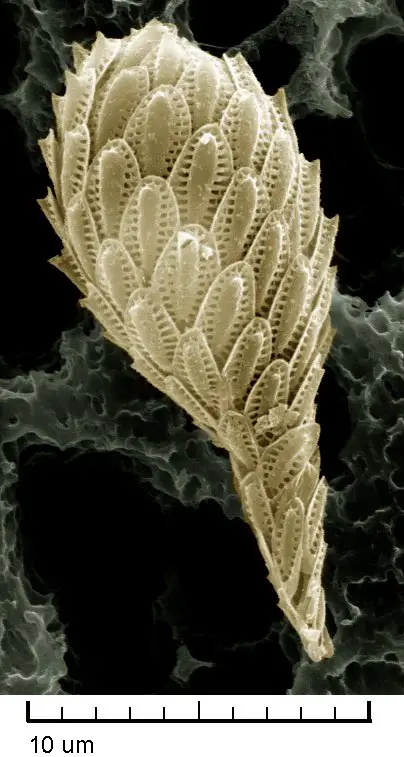
[In this image] SEM image (false color) of a single cell of Synura petersenii.
You can see the Synura cell covered in siliceous scales with a central spine and many pores.
Image source: wiki
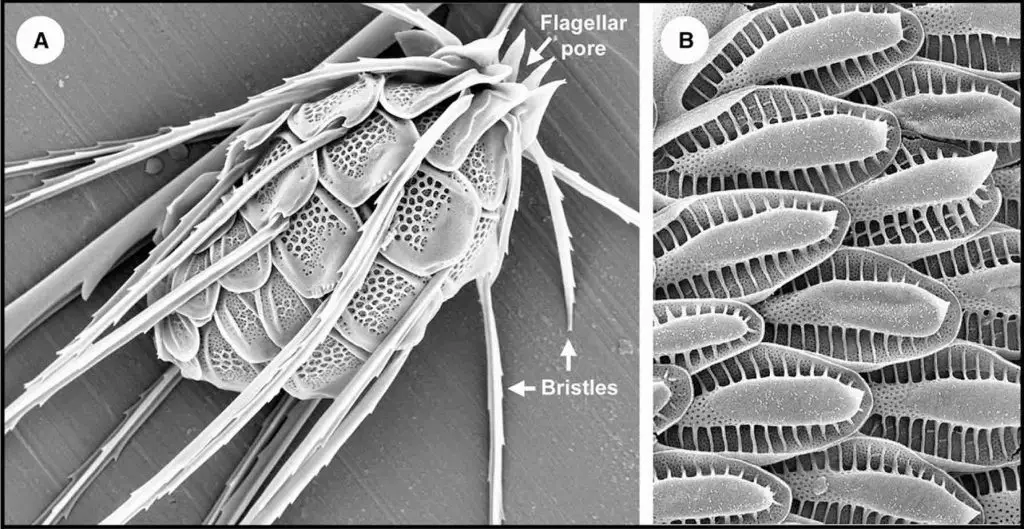
[In this image] SEM image of (A) the scales with long bristles on Mallomonas species; (B) detailed structure showing the spines, ribs, and pores.
Image source: Jo BY., et. al., European Journal of Phycology, 2016

[In this image] By phase-contrast microscopy, you can also see these scales covered the cells of Synura petersenii.
Image source: plingfactory
Like the siliceous remains of diatom cells, the siliceous scales of Synura persist in the environment and remain intact within sediments after the cell has died. These preserved scales (fossils) provide an important tool that helps ecologists to reconstruct environmental changes over time and to better understand the ecology of a particular system.
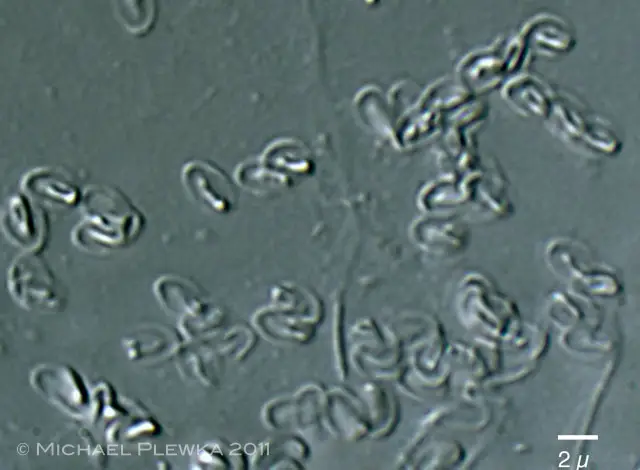
[In this image] The scales remain even after the Synura cells have died.
Image source: plingfactory
Unlike the diatoms, Synuras can survive without their protective scales if silica is unavailable. Naked Synura cells can regrow their scales within 24 hours with a sufficient supply of silica.
How do Synura form a sphere?
Synura is a single cellular alga. However, a group of Synuras likes to assemble into a swimming colony. The size of the colony usually ranges from 30-100 μm in diameter, depending on the number of Synura cells. In colonies of only a few cells, the cells are usually more spherical in shape, while in larger colonies the cells are normally club-shaped and packed more tightly together.
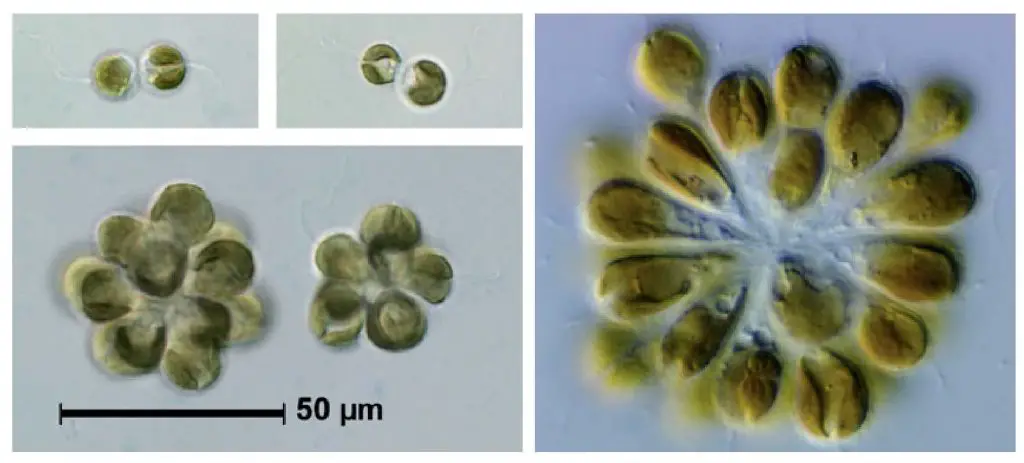
[In this image] Synura colonies assemble from a variable number of cells.
Image source: Modified from Synura Ehhrenberg
In each colony, Synura cells join together with their posterior ends staying inside. Each cell has two flagella that protrude along the edge of the colony to permit a rolling, tumbling, swimming motion. When all these flagella wave in a coordinated fashion, the whole spherical cluster can swim and roll.
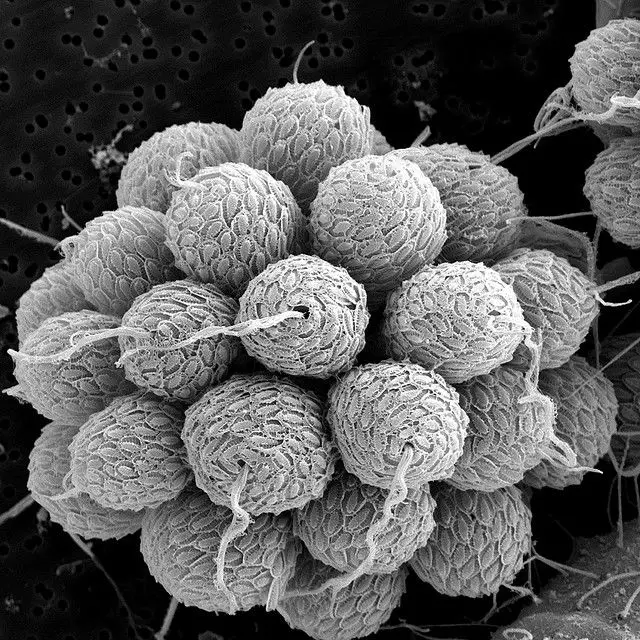
[In this image] SEM image of a Synura colony.
You can see scale-covered Synura cells with two flagella.
Image source: University Kassel, Digital Design Department.
Each cell in a Synura colony is independent. Unlike other clustering algae (i.e., volvox), the members of the Synura cluster are dynamic and can easily separate and re-assemble. There is no cytoplasmic connection or bridge in-between two Synura cells.

[In this image] The disassembling and re-assembling of a Synura colony. Disassembling might be triggered by environmental stresses, like temperature change and low oxygen in the water.
Extended Read: Volvox – The emerald green algae of the micro world
Where do Synuras live?
Synuras live in freshwaters like lakes, ponds, and slow-moving rivers or streams. They like warmer weather and are often abundant in temperate, subtropical, and tropical environments, but are much less abundant and diverse in arctic and subarctic habitats. Like other microscopic algae, Synuras are an important food source for many aquatic animals.
Synura sometimes moves to deep waters at night to avoid predators and to take advantage of available nutrients. During the day, the cells remain closer to the surface waters for more sunlight.
[In this video] Synura – the blooming of golden algae.
Why Synura blooms are stinky?
Synuras sometimes form blooms (usually in the spring) and dye the water yellow. They also release ketones and aldehydes that can give the water an unpleasant fish-like odor or taste.
How do Synuras reproduce?
Synura cells usually reproduce by binary fission, asexual reproduction. In the process, the parent cell splits into two daughter cells which get half of the parent cell’s scales. The new cells can regrow the scales and grow back into their normal size. They can also perform sexual reproduction.
Who discovered Synura?
The genus Synura was first described in 1834 by the German microscopist Christian Gottfried Ehrenberg (1795–1876). He also described thousands of new species, among them the well-known flagellates such as Euglena, ciliates such as Paramecium aurelia, and Paramecium caudatum, unicellular diatoms and dinoflagellates, and many fossils.
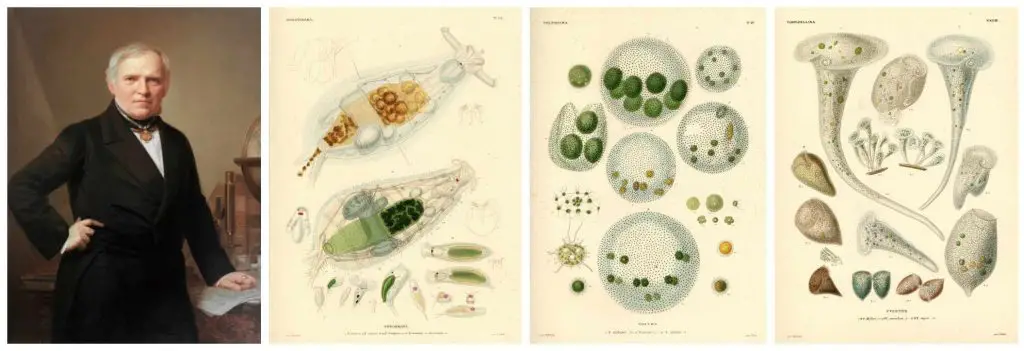
[In this image] Christian Gottfried Ehrenberg and his illumination of rotifers, volvox, and stentors.
Image source: wiki
Summary
1. Synura is a small group of golden-brown algae containing chloroplasts, found mostly in freshwater.
2. A group of Synura cells can aggregate and assemble into a cluster. Each cell has its two flagella facing outward. When they wave their flagella together, the entire cluster starts to rotate, so I called them microscopic “Roasted Corn on the Cob.”
3. Synuras sometimes form blooms (usually in the spring) and dye the water yellow. They also release ketones and aldehydes that can give the water an unpleasant fish-like odor or taste.
4. Synura contains one nucleus, two golden-brown chloroplasts, two flagella, and a big vacuole. The cell is covered by many protective scales made of silica.
5. Synura use asexual reproduction and sexual reproduction.

